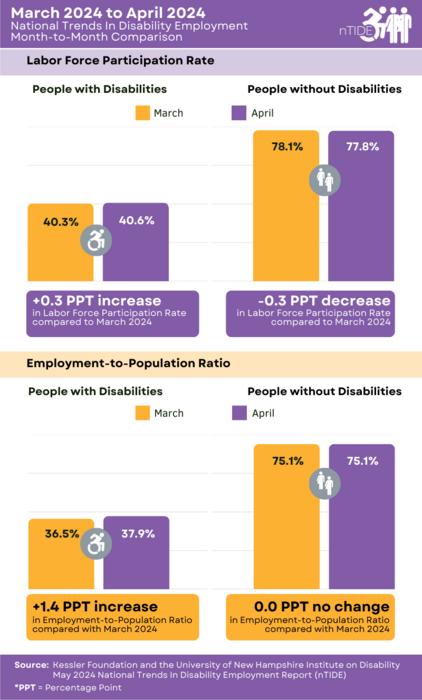East Hanover, NJ – May 3, 2024 – Following a two-month decline, the employment of individuals with disabilities returns to near historic highs reported by nTIDE in late 2023, reaffirming the significance of those prior highs. That’s according to today’s National Trends in Disability Employment – semi-monthly update (nTIDE), issued by Kessler Foundation and the University of New Hampshire’s Institute on Disability (UNH-IOD).

Credit: Kessler Foundation
East Hanover, NJ – May 3, 2024 – Following a two-month decline, the employment of individuals with disabilities returns to near historic highs reported by nTIDE in late 2023, reaffirming the significance of those prior highs. That’s according to today’s National Trends in Disability Employment – semi-monthly update (nTIDE), issued by Kessler Foundation and the University of New Hampshire’s Institute on Disability (UNH-IOD).
Month-to-Month nTIDE Numbers (comparing March 2024 to April 2024)
“Following two months of decline, individuals with disabilities are now edging back towards their near historic highs from late 2023,” remarked Elaine E. Katz, MS, CCC-SP, Senior Vice President Grants & Communications at Kessler Foundation.
Based on data from the U.S. Bureau of Labor Statistics (BLS) Jobs Report released today, the employment-to-population ratio for people with disabilities (ages 16-64) increased from 36.5 percent in March 2024 to 37.9 percent in April 2024 (up 3.8 percent or 1.4 percentage points). For people without disabilities (ages 16-64), the employment-to-population ratio remained the same at 75.1 percent in both March 2024 and 2024. The employment-to-population ratio, a key indicator, reflects the percentage of people who are working relative to the total population (the number of people working divided by the number of people in the total population multiplied by 100.
In April, the labor force participation rate for people with disabilities (ages 16-64) increased from 40.3 percent in March 2024 to 40.6 percent in April 2024 (up 0.7 percent or 0.3 percentage points). For people without disabilities (ages 16-64), the labor force participation rate decreased from 78.1 percent in March 2024 to 77.8 percent in April 2024 (down 0.4 percent or 0.3 percentage points). The labor force participation rate reflects the percentage of people who are in the labor force (working, on temporary layoff (on furlough), or actively looking for work in the last four weeks) relative to the total population (the number of people in the labor force divided by the number of people in the total population multiplied by 100.
Year-to-Year nTIDE Numbers (comparing April 2023 to April 2024)
“The labor force participation of people with disabilities increased slightly over the last few months,” said Andrew Houtenville, PhD, professor of economics and research director of the UNH-IOD. “People with disabilities are still engaged in the labor force at a similar rate to last month, although a bit below the all-time highs seen in late 2023,” he added.
The employment-to-population ratio for people with disabilities (ages 16-64) increased from 35.6 percent in April 2023 to 37.9 percent in April 2024 (up 6.5 percent or 2.3 percentage points). For people without disabilities (ages 16-64), the employment-to-population ratio remained the same at 75.1 percent in both April 2023 and April 2024.
The labor force participation rate for people with disabilities (ages 16-64) increased from 38.3 percent in April 2023 to 40.6 percent in April 2024 (up 6 percent or 2.3 percentage points). For people without disabilities (ages 16-64), the labor force participation rate also increased from 77.4 percent in April 2023 to 77.8 percent in April 2024 (up 0.5 percent or 0.4 percentage points).
In April, among workers ages 16-64, the 6,370,000 workers with disabilities represented 4.2 percent of the total 150,473,000 workers in the U.S.
Ask Questions about Disability and Employment
Each nTIDE release is followed by an nTIDE Lunch & Learn online webinar. This live broadcast, hosted via Zoom Webinar, offers attendees Q&A on the latest nTIDE findings, provides news, updates from the field, and features invited panelists who discuss current disability-related findings and events.
On May 3, 2024, at 12:00 pm – 1:00 pm Eastern, guest presenter Adene Karhan, LCSW, from CAPE-Youth, joined Dr. Houtenville and Denise Rozell, AUCD. Join our free Lunch & Learn live or visit the nTIDE archives at ResearchonDisability.org/nTIDE. Also, register now for our mid-month Deeper Dive into employment trends at nTIDE Deeper Dive – 05/17/2024.
NOTE: The statistics in the nTIDE are based on BLS numbers but are not identical. They are customized by UNH to combine the statistics for men and women of working age (16- 64). nTIDE is funded by the National Institute on Disability, Independent Living and Rehabilitation Research (NIDILRR; 90RTGE0005) and Kessler Foundation.
About the Institute on Disability at the University of New Hampshire
The Institute on Disability (IOD) at the University of New Hampshire (UNH) was established in 1987 to provide a university-based focus for the improvement of knowledge, policies, and practices related to the lives of persons with disabilities and their families. For information on the NIDILRR-funded Research and Training Center on Disability Statistics, visit ResearchOnDisability.org.
About Kessler Foundation
Kessler Foundation, a major nonprofit organization in the field of disability, is a global leader in rehabilitation research. Our scientists seek to improve cognition, mobility, and long-term outcomes, including employment, for adults and children with neurological and developmental disabilities of the brain and spinal cord including traumatic brain injury, spinal cord injury, stroke, multiple sclerosis, and autism. Kessler Foundation also leads the nation in funding innovative programs that expand opportunities for employment for people with disabilities. For more information, visit KesslerFoundation.org.
Press Contacts at Kessler Foundation:
Deborah Hauss, DHauss@kesslerfoundation.org
Carolann Murphy, CMurphy@KesslerFoundation.org
Stay Connected with Kessler Foundation
X (formerly known as Twitter) | Facebook | YouTube | Instagram | SoundCloud



